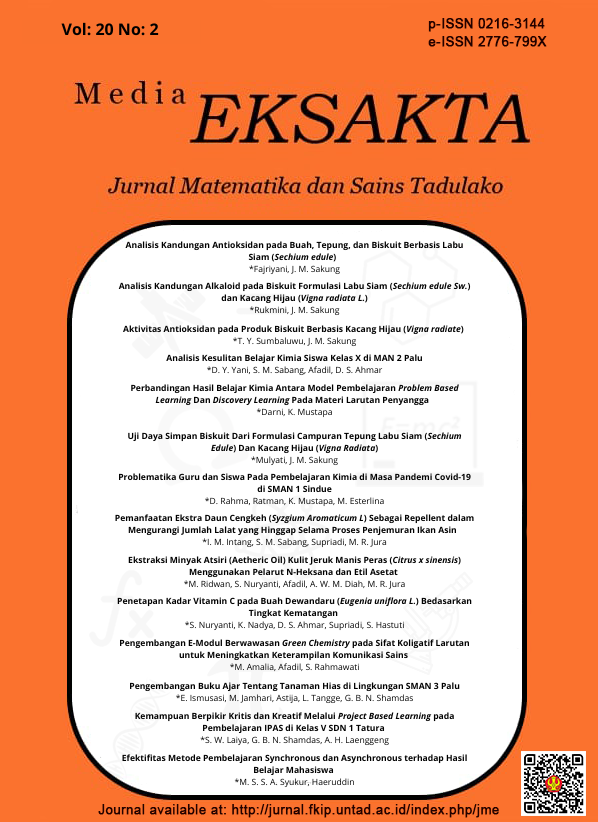Test of Biscuit Storability From Mixed Formulation of Chayote Pumpkin Sechium Edule and Mung Bean Vigna Radiata Flour
Keywords:
Storability Test, Chayote Flour, Green Bean FlourAbstract
The purpose of this study was to determine the shelf life of biscuits from a mixture of chayote flour (Sechium edule) and mung bean (Vignaradiata) flour. This research is a laboratory experimental research conducted to determine the shelf life or shelf life of biscuits from chayote flour and mung bean flour formulations. The samples used in this study were biscuits made from chayote flour (Sechium edule) and green beans (Vignaradiata). This research was conducted in the Chemistry Laboratory of the Teaching and Education Faculty of Tadulako University. This research was carried out in June-September 2020 which began with the manufacture of biscuits from the formulation of chayote flour and green beans. The tools used in this study were containers, knives, ovens, blenders, sieves, spoons, platovens, cake ovens, analytical balances, porcelain cups, desiccators. Data analysis for estimating the shelf life of biscuits using the Arrhenius method. The results of the research using the ASLT method. Based on the results obtained, the shelf life of biscuits from a mixture of chayote flour (Sechium edule) and green bean (Vignaradiata) formulation was the highest, obtained by 100% chayote squash at 25 oC for 177 days. The highest 100% green beans were obtained at 25 oC for 176 days. The highest 50% chayote squash and 50% green beans were obtained at 25 oC for 187 days. The highest 75% chayote squash and 25% green beans were obtained at 25 oC for 170 days. The highest 25% chayote squash and 75% mung bean were obtained at 45oC for 195 days. Suggestions in this study are expected to be a reference for future researchers to examine and further deepen this issue, as well as analysis of other secondary metabolic compounds in biscuits from the formulation of chayote flour and green beans.
References
Adi, D. K., Parnanto, N. H. R., & Ishartani, D. “Pendugaan Umur Simpan dan Aktivitas Antioksidan Manisan Kering Pare Belut (Trichosanthes anguina L.) sebagai Camilan Sehat dengan Pemanis Sorbitol”. Jurnal Teknosains Pangan, 5(2), 2016, pp 9-18.
Asiah, N., Cempaka, L., & David, W. “Panduan praktis pendugaan umur simpan Produk pangan”. Peneribit Universitas Bakrie, 2018
Awaludin, E., Sakung, J., & Baculu, E. P. H. “Analisis Kandungan Zat Gizi Makro Dan Uji Organoleptik Brownies Kukus Berbasis Labu Siam”. Jurnal Kolaboratif Sains, 1(1), 2019
Chaniago, R. “Ragam Olahan Sayur Indigenous Khas Luwuk”. Sleman: Deepublish, 2019
Del Giudice, I., Limauro, D., Pedone, E., Bartolucci, S., & Fiorentino, G. “A novel arsenate reductase from the bacterium Thermus thermophilus HB27: its role in arsenic detoxification”. Biochimica et Biophysica Acta (BBA)-Proteins and Proteomics, 1834(10), 2013, pp 2071-2079.
Dewanto, S. A., Nisa, F. Z., MP, S., & Utami, F. A. “Pengaruh Penambahan Tepung Labu Siam Terhadap Perbedaan Karakteristik Sensoris Dan Daya Terima Cookies”. Universitas Gadjah Mada, Yogjakarta, 2019
Dewi, Y. I. “Efektifitas kombinasi terapi kukusan labu siam dan senam anti stroke terhadap penurunan tekanan darah pada Pasien dengan hipertensi”. Riau University, Pekan Baru, 2014
Diniyati, B., & Rustanti, N. “Kadar Betakaroten, Protein, Tingkat Kekerasan, dan Mutu Organoleptik Mie Instan dengan Substitusi Tepung Ubi Jalar Merah (Ipomoea Batatas) dan Kacang Hijau (Vigna radiata)”, Diponegoro University, Semarang, 2012
Dwi Daryono, E. “Ekstraksi pektin dari labu siam”. Jurnal teknik kimia, 7(1), 2013, pp 22-25.
Esa Putri Nabella, E. P. N., Jafri, Y., Sesrianti, Nr Vera, & Sesrianti, N. V. “Asuhan keperawatan pada keluarga Bapak S khususnya pada bapak s dengan hipertensi dalam pemberian terapi komplementer: perasan labu siam untuk menurunkan tekanan darah di Jorong Koto Gadang Kec. Baso Kab. Agam tahun 2019”. STIKes Perintis Padang, Padang, 2019
Estiari, E., Parnanto, N. H. R., & Sari, A. M. “Pengaruh Perbandingan Campuran Labu Siam (Secheum Edule) Dan Brokoli (Brassica Oleracea Var Italica) Terhadap Karakteristik Fisik, Kimia Dan Organoleptik Mix Fruit And Vegetable Leather”. Jurnal Teknosains Pangan, 1(1), 2016, pp 1-9.
Fadliya, F., Supriadi, S., & Diah, A. W. M. “Analisis Vitamin C dan Protein pada Biji Buah Labu Siam (Sechium edule)”, Jurnal Akademika Kimia, 7(1), 2018, pp 6-10.
Fatmasari, D. “Diversifikasi Produk Buah Labu Siam Di Dusun Mantran Wetan Desa Girirejo Kecamatan Ngablak Kabupaten Magelang”. Majalah Ilmiah Inspiratif, 2(4), 2017, pp 45-49.
Harris, H., & Fadli, M. “Penentuan Umur Simpan (Shelf Life) Pundang Seluang (Rasbora Sp) Yang Dikemas Menggunakan Kemasan Vakum Dan Tanpa Vakum”, SAINTEK PERIKANAN: Indonesian Journal of Fisheries Science and Technology, 9(2), 2014, pp 53-62.
Istinganah, M., Rauf, R., & Widyaningsih, E. N. “Tingkat Kekerasan dan Daya Terima Biskuit dari Campuran Tepung Jagung dan Tepung Terigu dengan Volume Air yang Proporsional”, Jurnal Kesehatan, 10(2), 2017, pp 83-93.
Downloads
Published
How to Cite
License
Copyright (c) 2024 Mulyati, J. M. Sakung

This work is licensed under a Creative Commons Attribution-ShareAlike 4.0 International License.
Authors who publish with Jurnal Media Eksakta agree to the following terms:
- Authors retain copyright and grant the journal right of first publication with the work simultaneously licensed under a Creative Commons Attribution License (CC BY-SA 4.0) that allows others to share the work with an acknowledgment of the work's authorship and initial publication in this journal.
- Authors are able to enter into separate, additional contractual arrangements for the non-exclusive distribution of the journal's published version of the work (e.g., post it to an institutional repository or publish it in a book), with an acknowledgment of its initial publication in this journal.
- Authors are permitted and encouraged to post their work online (e.g., in institutional repositories or on their website) prior to and during the submission process, as it can lead to productive exchanges, as well as earlier and greater citation of published work.




